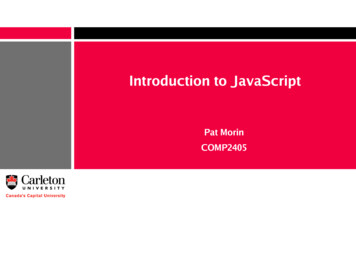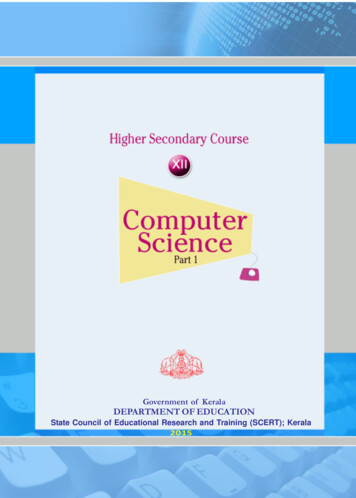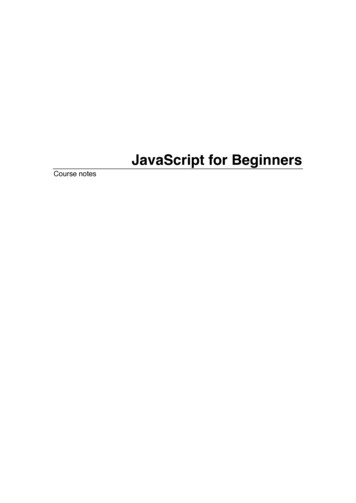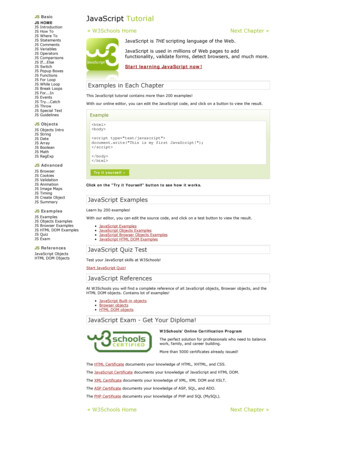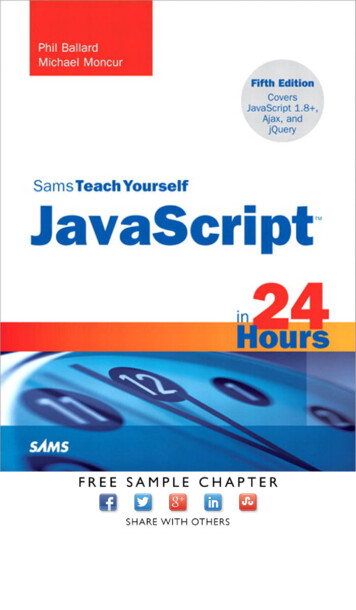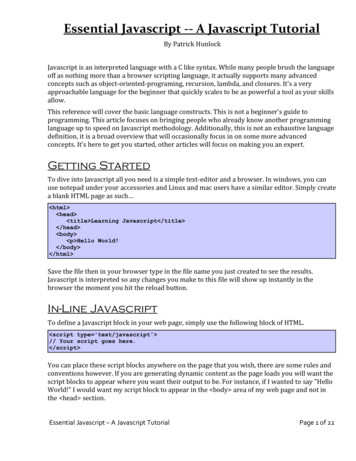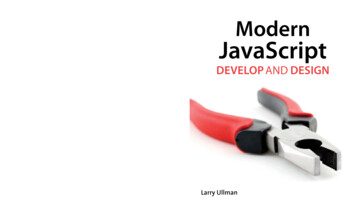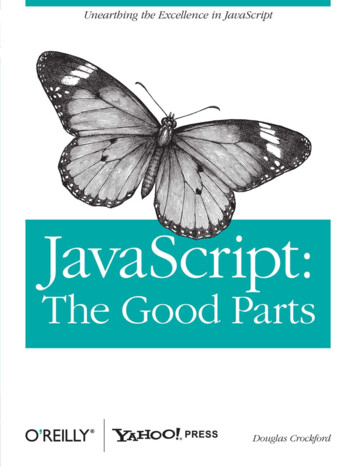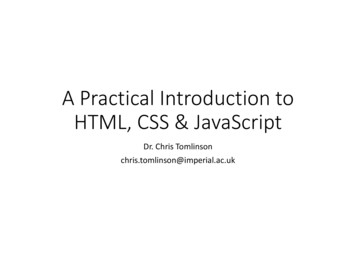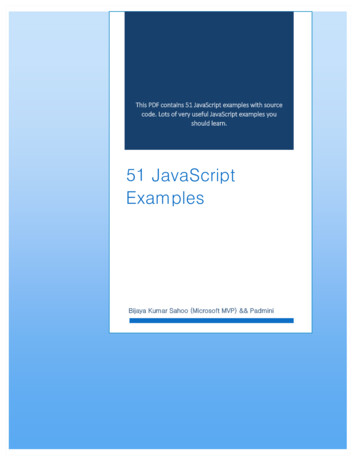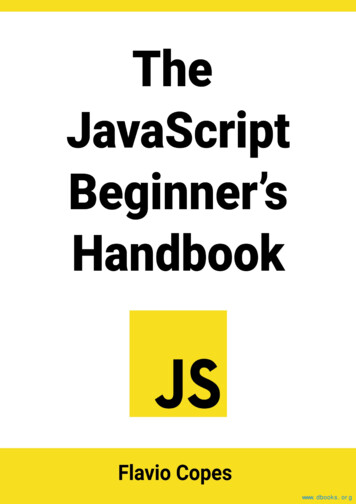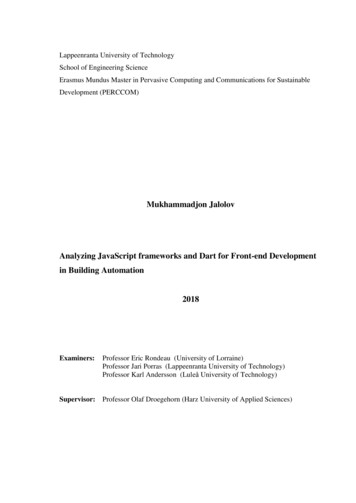
Transcription
Lappeenranta University of TechnologySchool of Engineering ScienceErasmus Mundus Master in Pervasive Computing and Communications for SustainableDevelopment (PERCCOM)Mukhammadjon JalolovAnalyzing JavaScript frameworks and Dart for Front-end Developmentin Building Automation2018Examiners:Professor Eric Rondeau (University of Lorraine)Professor Jari Porras (Lappeenranta University of Technology)Professor Karl Andersson (Luleå University of Technology)Supervisor: Professor Olaf Droegehorn (Harz University of Applied Sciences)
This thesis is prepared as part of an European Erasmus Mundus programmePERCCOM – Pervasive Computing & COMmunications for sustainable development.This thesis has been accepted by partner institutions of the consortium (cf. UDL-DAJ,n 1524, 2012 PERCCOM agreement).Successful defence of this thesis is obligatory for graduation with the following nationaldiplomas: Master in Complex Systems Engineering (University of Lorraine) Master of Science in Technology (Lappeenranta University of Technology) Master of Science in Computer Science and Engineering, Specialisation: PervasiveComputing and Communications for Sustainable Development (Luleå University ofTechnology)ii
ABSTRACTLappeenranta University of TechnologySchool of Engineering ScienceErasmus Mundus Master Program PERCCOMMukhammadjon JalolovAnalyzing JavaScript frameworks and Dart for Front-end Development in BuildingAutomationMaster’s Thesis72 pages, 38 figures, 8 tables, 6 formulas, 1 appendixExaminers: Professor Eric Rondeau (University of Lorraine)Professor Jari Porras (Lappeenranta University of Technology)Professor Karl Andersson (Luleå University of Technology)Keywords: JavaScript Frameworks, Dart, Home Automation, Frontend, MaintainabilityBuilding or Home automation systems (BAS), (HAS) can inarguably reduce energyconsumption. However, the widespread adoption of BAS is still inferior due tosophisticated user interfaces (UI). In fact, JavaScript (JS) is the primary tool for webapplications with dozens of frameworks (JSf). Such an abundant number of JSf requireempirical comparison to select the optimal JSf for building highly acceptable BAS UIswith less complexity and efforts. Therefore, based on open source HAS – FHEM, thisstudy analyzes JSfs and Dart language (Dart) in the field of BAS using code analysis toolsto extract metrics on software maintainability in different UI scenarios in order to guide theBAS UI developers towards the convenient JSfs which require less efforts to build a UI.The study also studies the MVC design pattern support. The qualitative data analysis isdone to identify the distinctions of JSfs and quality attributes. The research has selectedAngularJS, Angular2, Ember and React JSfs. Online survey is also done for better results.The results show that each framework comes with their different advantages.iii
ACKNOWLEDGEMENTSThis thesis work is funded by and is a part of the European Erasmus Mundus programme(Pervasive Computing and COMmunications for sustainable development) [52]. Theauthors are grateful to the Erasmus programme of the European Union, academia,companies, and associate partners of the PERCCOM Consortium.First of all, I would like to thank sincerely to the PERCCOM committee for giving me agreat opportunity for participating in the program which literally turned me into a personwith aspirations towards sustainability. The last two years were more than just a studyabroad for me. PERCCOM program contributed my immense development in the field ofICT.My deep gratitude to my supervisor Prof. Dr. Olaf Droegehorn for guiding me through thehardship of the research work with his advises and helps. The contribution of ProfessorJosef Hallberg to my thesis work accomplishment is priceless.I would also express my special thanks to professors – Eric Rondeau, Jean-PhillipeGeorges, Jari Porras, Ah Lian Kor, Karl Andersson, Collin Pattinson, Alexandra Klimovaand Penzenstadler Birgit Peters. Moreover, my warm thanks to PhD student – MariaVictoria Palasin Silva for her guidance during my second semester.The completion of this research work would not be possible without the support of mydearest people in life – parents and siblings. They have always been given me strengthencouraging me to be patient during difficulties, motivating to be stronger, inspiring forhigher achievements. Thank you for everything my family! My greetings to all of myPERCCOM classmates, together with them PERCCOM was fun and happy journey.iv
TABLE OF CONTENTS12INTRODUCTION .41.1BACKGROUND.41.2MOTIVATION .51.3RESEACH OBJECTIVES AND QUESTIONS .61.4DELIMITATIONS .61.5RESEARCH METHODS.71.6THESIS CONTRIBUTIONS .81.7STRUCTURE OF THE THESIS .8LITERATURE REVIEW .92.1OVERVIEW .92.1.1Building Automation Systems .92.1.2JavaScript, JavaScript frameworks and Dart .122.1.3Software metrics and Maintainability .172.2RELATED WORK .222.2.1Home automation frontends design .222.2.2JavaScript Frameworks Comparison .252.2.3Measuring Software Maintainability .322.33SUMMARY OF THE LITERATURE REVIEW .36RESEARCH METHOD .373.14QUALITATIVE DATA ANALYSIS APPROACH .393.1.1Data collection .393.1.2Data analysis .403.2HOME AUTOMATION FRONTEND SCENARIOS .403.3ONLINE SURVEY DESIGN .413.4SUMMARY OF THE RESEARCH METHOD .42IMPLEMENTATION .434.1SYSTEM ARCHITECTURE .434.2DEVELOPED USER INTERFACES .444.3SOFTWARE METRICS EVALUATION .514.4SUMMARY OF THE IMPLEMENTATION .521
5RESULTS .535.165.1.1Community .535.1.2Other attributes .545.2SOFTWARE METRICS RESULTS .555.3MVC DESIGN PATTERN SUPPORT .595.4ONLINE SURVEY RESULTS .625.5SUMMARY OF THE RESULTS .66ANALYSIS AND DISCUSSION .676.17QUALITATIVE DATA ANALYSIS RESULTS .53SUSTAINABILITY ANALYSIS.69CONCLUSION AND FUTURE WORK .72REFERENCES.73APPENDIX 1. .792
LIST OF SYMBOLS AND ABBREVIATIONSBASBuilding Automation SystemCCCyclomatic ComplexityDartGoogle Dart LanguageDOMDocument Object ModelECAEvent-Condition-ActionGeSiGlobal e-Sustainability InitiativeHASHome Automation SystemIEEEThe Institute of Electrical and Electronics EngineersISOInternational Organization for StandardizationJSJavaScriptJSfJavaScript frameworkJSXJavaScript XMLMIMaintainability IndexSPASingle page applicationUIUser InterfaceUXUser experience3
1INTRODUCTIONThis work carries out a research on the most popular frameworks and Dart language in thefield of home automation systems. The differences in software architecture, the support ofdesign patterns and the scope of framework capabilities will be analyzed. This chapterpresents the introduction to the research work.1.1 BackgroundAccording to Smarter2030 report by GeSi [1], buildings consume over 40% of the totalenergy worldwide and it is believed that smart building solutions can alleviate the problem.In the EU, CO2 emissions by buildings represent 36% out of the total greenhouse gasemissions [2]. The energy consumption of buildings can be reduced by using buildingautomation systems (BAS) as a smart building component, while at the same time thesesmart systems can also bring comfort, climate control, security and others [3].However, regardless of abounding benefits, there are several issues pertaining to largescale adoption and utilization of BAS by households. Inhabitants without technical skillshave huge challenges to manage, troubleshoot and eventually cannot take an advantagefrom the Home Automation Systems (HAS) [4]. Difficulty of customization of homeautomation systems (HAS), the complexity of their user interfaces and their prices are themain barriers of adoption these systems [5]. However more commercial smart hometechnologies are being released and available over time which is also influencing theirprices and their costs are declining [6]. Ultimately, the main limitations of the HAS aretheir user interfaces. Smart home frontends face challenges to incorporate all featuresabout navigation, conveying large amount of information in understandable format,supporting easy interaction for users and others [4].Usually BAS are controlled by the UIs made of browser-based web applications.JavaScript is amongst the main languages for web technologies and it stands in solid top 10of most used programming languages [7]. Nevertheless, JavaScript frameworks (JSf) havebeen created to ease programmers’ tasks and the number of these JSf grew dramaticallycounting for hundreds [8]. Only few studies compare JSf considering source code4
maintainability, ease of programming, ease of design. Therefore, this thesis carries out anempirical analysis of JSfs and Google Dart programming language (Dart) for intuitive,widely acceptable BAS frontends. This leads BAS frontend developers to the choice of anoptimal framework for their needs with a help of experimental documentation.1.2 MotivationAround half of the total produced energy is consumed by buildings, houses and almost 40percent of the carbon dioxide comes from the buildings sector [1]. In fact, carbon dioxideis known as the greenhouse gas that is responsible for temperature rises. Today we can seethat changes in the global temperature even for few centigrade may end up withcatastrophic consequences raising sea levels, climate shifts, and unpredictable weatherconditions. These facts can show the essence and urgency of taking actions to reduce theseemissions via reducing energy consumption.Energy consumption of buildings could be reduced using home automation systems. Therehave been many facts about the energy saving potentials of smart homes [3]. However, anynew technology may face challenges in its early adoption phase and sometimes evenresistance to use it. However, in case of home automation technologies the primaryproblems are their complex user interfaces that are hard to use [5].Therefore, this thesis work aims at exploring JavaScript frameworks and Dart language asthe promising and widely accepted technologies worldwide to build home automation userinterfaces. This research primarily investigates the ease of development, maintainabilityand software design pattern aspects of JS frameworks and Dart. It is acknowledged factthat maintaining costs of a software product escalates with the increase of efforts needed tomaintain a software component. Hence, the overall budget of the software productincreases as well [9]. Thus, the main goal of carrying out this thesis work is to reduce thedevelopment and maintenance efforts of developers to build HAS frontends and by this tocontribute to the popularity of home automation systems. The contribution from this studyto the energy savings may not be immediate however even a few number installations ofhome automation systems by people or reducing efforts to build a HAS user interface willbring about positive enabling effects.5
1.3 Reseach objectives and questionsThe objectives of this thesis work are the following:1. Assist home automation frontend developers to select a particular JavaScriptframework or Dart language through providing comparative analysis of theseframeworks.2. Investigate the support and benefits of the MVC/MVP design patterns in differentJavaScript frameworks and Dart to identify their relevance for programming homeautomation frontends.3. Compare maintainability, design aspects of JavaScript frameworks and Dart indifferent HA scenarios in order to reduce HAS frontend development efforts.The following research questions are addressed within this study:1. What are the main differences of JS frameworks as well as Dart?2. How are the MVC/MVP design patterns are supported by the selected JSframeworks and Dart?3. Which maintainability metrics can be applied and compared from JSframeworks/Dart?4. In which HAS scenarios JS frameworks/Dart to be compared?1.4 DelimitationsMany home automation systems exist in the market such as Fhem, Calaos, Home Assistantand others. Developers can also choose a preferred building automation protocols from theset of many well-known ones such as KNX, ZWave, M-Bus, EnOcean, HomeMatic andmany others. This thesis does not evaluate these protocols and focuses on frontendsoftware source codes. Also, this work is completed adopting existing open source HomeAutomation (HA) server – FHEM as a platform for the experiments. The FHEM server iswritten in the Perl language and supports a huge number of HA protocols and additionally,up-to-date modern technologies like Alexa, iTunes, TV sets and many more. Worth6
mentioning that, FHEM system has a quite primitive UI and a complex configurationprocess.In addition, the scope of the communication means from designed user interfaces and toFHEM home automation server is only Websockets connection. Due to convenience andavailability of Websocket libraries to almost all JS frameworks and programminglanguages, this thesis work utilizes Websockets. Moreover, worth to mention thatWebsockets are one of the only few existing connection means to FHEM platformdeveloped by the FHEM contributors. Therefore, other technologies such as REST API arenot reviewed and the thesis scope is limited to Websocket usage. Lastly, the styling aspectof the frontends is also not considered as a part of the main research process and onlyJavaScript as well as Dart source codes are the main focus of the thesis.1.5 Research MethodsIn order to answer the research questions one and three – RQ1 and RQ3, a comprehensiveliterature review is done. This forms a solid blueprint for the following steps of theresearch and identifies missing gaps in JS frameworks comparison works. Specifically forthe RQ3, it is important to find out which exact software metrics to employ in this studyand by which tools we can cover as many frameworks at once to gain standard results. Inaddition, answering the RQ1 is done through deeper systematic approach via datacollection and mapping study. The reason for that is comparative works on JS frameworksare highly distributed over the articles and research papers where if some frameworks arecompared to each other, others are not included and vice versa. Analyzing MVC designpattern support as outlined in RQ2 requires writing the scripts in real projects. Moreover,online surveys are intended to present developers point of view in this study. Lastly, for theRQ4, few home automation scenarios have been designed which take into account andalleviate the main issues the end users face nowadays to adopt HAS. These obstacles arealready mentioned and include complexity of the UIs and configuration, navigation in theapplication, energy monitoring and others. The designed UIs consider these issues and arerepresented as the solved UIs themselves.7
1.6 Thesis contributionsThe main contribution of this thesis work is to provide practical guidance for homeautomation user interface developers, supplying social and technical aspects of thesustainability with valuable documentation. Due to high popularity of JavaScriptframeworks in the modern and interactive user interface development in the world, thecomparative exploration of these technologies would facilitate the acceptance andexpansion of home automation frontends built using JavaScript frameworks. The largescale utilization of home automation technologies is in fact a tremendous driver for energysavings in the building sector.1.7 Structure of the thesisThis thesis work is structured as follows:-Chapter 2 highlights the scope of the thesis. It presents all important concepts ofhome automation systems, JavaScript frameworks, User interface requirements,software maintainability aspects as well as related works in the domain of JSframeworks comparison and methods of measuring software maintainability. Themethods to compare JS frameworks are also presented in this chapter.-Chapter 3 shows the research process. The thesis methodology, the online surveyapproach, the architecture of the experimental system and implementation of thehome automation frontend source codes are summarized in this chapter.-Chapter 4 describes the experimental platform on which the UIs are tested andsoftware metrics are obtained.-Chapter 5 presents the results from qualitative data analysis and software metricsobtained from the JS frameworks and Dart codes, online survey results and theMVC design pattern support and benefits by the frameworks.-Chapter 6 discusses all results collected from the experiments.-Chapter 7 summarizes the thesis work and introduces possible future work in thefield.8
2LITERATURE REVIEWThis chapter presents the base concepts of home automation systems, architecture and thebackground of the selected JavaScript (JS) frameworks, software maintainabilitymeasurement methods and the previous works done in this field of JavaScript frameworkscomparison. In addition to JS frameworks, the general concepts of the Dart language arealso reviewed in this chapter. This chapter plays a role of a foundation for the researchprocess.The literature review showed that many existing works on the JSf comparison were notperformed for the home automation frontends development or for a specific applicationdesign. The previous comparison studies are involved in JS features comparison withoutconsidering particular use cases.2.1 OverviewThis section highlights the generic information on building automation systems, JavaScriptand its frameworks and the main concepts of the Dart language. The FHEM platform, itsadd-ons and communication interfaces are discussed as well. Moreover, softwaremaintainability definition, its importance in software development processes, factors thatmay impact it and metrics to measure maintainability are reviewed in this section.2.1.1 Building Automation SystemsBuilding automation systems (BAS) perform control and monitoring of temperature, lights,ventilation, security and other home appliances. Tasks can be automated with the use ofBAS. Besides control and automation ability, these systems have a large potential toreduce energy consumption [3] [10]. BAS technologies are not a novation and manystandards have been developed such as Modbus, BACnet, KNX, ZigBee [10] [11].HAS frontends usually display a list of rooms or devices. Alternatively these UIs may alsovisualize the house in the form of floor and sometimes room plans for better accessibilityto the appliances [12] [4].9
In [13] and [6] two ways of interaction with HAS is shown – user-control and rule-basedautomation. Any tasks such as switching appliances on and off is performed via controlpanel in a user-control type of HAS. In a rule-based HAS applications, users are notexpected to write a complex code for rules although some HAS may require this such asFHEM. Rule-based automation is achieved with the support of conditional commands suchas “if”, “or”, “and”. For example, rules can be expressed in the way similar to – (“if” thedoor “opens”, then “activate” alarm). In addition this type of automation can be expandedas trigger-constraint-action which is also referred as Event-Condition-Action – ECA [6].ISO 16484-5 standard [14] defines a standard model for any type of BAS layering it intothree composite levels. Fig. 1 illustrates three levels of BAS. The lowest, Field level iscomposed of all hardware elements – sensors, actuators and each physical interaction withthe environment belongs to this level. The second, intermediate level – the automationlevel is responsible for controlling devices from Field level that is managed by controllers.The last and the upper level is the management level where the whole BAS is monitoredand controlled. This top level includes web servers, databases, protocol translating serversand UIs. This thesis performs research within this Management level of the BAS model notgoing into deep investigations on the other low levels.Management levelAutomation levelField levelFig. 1. Architectural levels of BASAccording to Sánchez, et al. [15], at the present time developers of HA applications mainlyuse software tools provided either by the device manufacturer or based on their ownpersonal experience. Moreover, BAS are usually developed by experts of the field whoprograms the system, selects and installs the needed hardware after gathering userrequirements, inclining towards a particular technology of the manufacturer. The usabilityof HAS frontends is however, often neglected.10
One of the well maintained BAS platforms is FHEM. FHEM is an open-source homeautomation server platform written in Perl language. FHEM can be controlled through itsbuilt-in frontends, telnet connection or via TCP/IP. It maintains many home automationprotocols, media devices, weather service, Google calendars and other appliances. Thesupported popular protocols are the following: KNX, ZWave, EnOcean, Philipps HUE,FRITZ!Dect, Intertechno, HomeEasy, X10 and others. FHEM s documentation includesdetailed command list with description Commandref1, Wiki Page2 (in German), Forum3 (inGerman) and YouTube tutorials (in German).In order to configure, program devices or send commands to them, one of the followingcommand types can be issued to FHEM: FHEM specific commands – e.g. set lamp off Shell commands – "fhem.pl 7072 "set lamp off"" Perl expressions – {fhem("set lamp off")}orThe built-in frontend of FHEM is not easy to configure and not intuitive which isillustrated in Fig. 2. By default, only the style of the UI can be changed in FHEM which ischange of background color and template for desktop/mobile.Fig. 2. The default frontends of hem.de/wiki/Hauptseite3https://forum.fhem.de/211
However, FHEM is a modular program, meaning that different devices belong to differentmodules. Some of the modules which can significantly improve the UI are Floorplan andInfoPanel. Moreover, the FHEM developers have created the following supplementary UIsand helper developments such as: Fronthem module – interface between FHEM and smartVISU frontend4 FHEM Tablet UI5 illustrated in Fig. 3. Charting Frontend6 Yet Another Frontend7As a communication means to FHEM: FHEM.JS8 is a Websocket connection implementation to FHEM, based on NodeJSserver.The fronthem module as an interface between FHEM and smartVISU frontend is achievedvia websockets interface. Tablet UI is based on jQuery library, font-awesome library andother dependencies. Charting frontend requires FHEM s DbLog module and MySQL,Postgres or similar database already installed. Yet Another Frontend YAF is based onJavaScript frameworks JQuery and JQuery UI.There have been some efforts of building UIs for FHEM based on AngularJS withWebsockets9 which is still under development and improvement. However, no projectsexist in FHEM community with user interfaces written in Dart, Ember or Reactframework.2.1.2 JavaScript, JavaScript frameworks and DartJavaScript is a prototype-based high level scripting language. This language has a highflexibility as functions in JavaScript can be objects or may have properties and ki/Neues Charting orne/neohome512
function closures, can be assigned to other objects and they can be stored in variables,objects or in arrays. They can also be passed as arguments to functions and functions canreturn functions [16]. Moreover, JavaScript allows prototypes, first-class functions andclosures. The interaction with the browser is performed via a complex event-basedmechanism. However, writing in JavaScript and maintaining its code is hard due to suchhigh flexibility [16].JavaScript is widely used for building interactive web applications by developers. Becauseof its high popularity, dozens of JS frameworks have been developed to ease the codewriting process. A software framework is a collection of libraries that comes with itssoftware architecture and principles for designing applications. Many popular JSframeworks (JSf) are built in MV* software design pattern where M-model, data for theapplication, V-stands for view which is how the template is displayed for users. The starcharacter can be C-controller, P-presenter or VM-view-model. [17] MVC pattern is widelyused for building user interfaces and helps separate the source code logic into three parts –model, view and controller [18]. The simple architectural view of MVC pattern isdescribed in Figure 2. In AngularJS, Ember and in other JS frameworks the View isdefined as a template in HTML while Model and Controller is defined in a code written inJavaScript [19]. AngularJS and Ember have strong template features for easing datadisplay and manipulation. One of them is Data Binding feature which is automatic way ofupdating the View in case of any changes in the Model [20].AngularJS is a Javascript Framework which is released in 2009 and the current latestversion is 1.6.7 as for 24 November 2017. AngularJS is built on MVVM (Model-ViewViewModel) design pattern. The main features of AngularJS are the following. Scope inAngularJS is an intermediary object between a Controller and View and it is referred as aModel. Template is an HTML file extended with AngularJS directives that add behaviorand attributes to HTML elements. Processed and rendered template is called as the View.Controllers are JavaScript functions that belong to a particular scope object and they areresponsible for application functionality and logic. AngularJS also composed ofExpressions, Compiler, Filter, Components, Module and Services. Automatic data-binding,13
Routing, Dependency Injection, Animations and other features are supported inAngularJS.10 The architecture of AngularJS is shown in Fig. 3.Fig. 3. AngularJS architecture11Angular (Angular2 versions) is a JavaScript framework which was released in Septemberof 2016 and is maintained by the Google company. Since Angular2, other versions werealso introduced over time – Angular 4 (no Angular3 version), Angular5 and the latestversion Angular6 is available from March 2018 [21] [22].One of the most distinct features of the Angular is that Angular2 applications are writtenin TypeScript language as opposed to old AngularJS versions which are JavaScript based.Although TypeScript can be a learning obstacle for developers, it supports all the featuresexistent in JavaScript language. Most importantly TypeScript is an object-orientedlanguage [22]. Another noticeable change that took
School of Engineering Science Erasmus Mundus Master Program PERCCOM . (Dart) in the field of BAS using code analysis tools to extract metrics on software maintainability in different UI scenarios in order to guide the . AngularJS, Angular2, Ember and React JSfs. Online survey is also done for better results.
